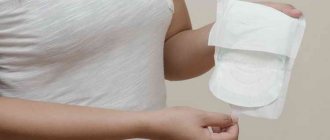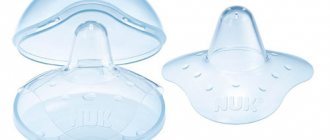A small child requires maximum attention from adults. After all, he has found himself in a world completely alien to him and it will take a lot of time before he adapts to it. And now the baby is very vulnerable and requires special care with daily hygiene. The baby's nose is cleaned, its eyes are washed, and it is washed. Pediatric doctors advise examining the child daily, paying special attention to the groin and skin folds. This is especially true for girls.
Newborn girls experience vaginal discharge. And this, according to doctors, is not something to be afraid of. This is not a pathology, this is the norm for a newborn. Experts call this phenomenon a sexual crisis.
The sexual crisis frightens parents because the discharge in newborn girls is bloody, which in the eyes of parents, especially young ones, is an undoubted pathology. And they start to panic.
As pediatricians say, discharge in newborn girls is quite normal. Thus, the child’s body starts the cleansing process, adapting to life in an environment that is new to it. The thing is that before childbirth, the mother’s body accumulates estrogens - these hormones are necessary to activate the birth process. Accordingly, the child’s body receives them, and in excess. But while the child is in the intrauterine state, this is the norm for him.
But after childbirth, communication with the mother ceases. Accordingly, the supply of these hormones to the child’s body stops. But they are still unnatural for him, so he begins to cleanse himself of them. It begins on the third or fourth day of life and lasts an average of 2 weeks. But sometimes the process takes up to 6-8 weeks.
Manifestation
In addition to vaginal discharge, the child’s mammary glands may swell and swell. There is no need to be afraid of this. How not to, and squeeze them out.
Children also develop acne. In boys, and they also receive these hormones from their mother, the genitals and mammary glands swell and swell.
But as mentioned above, there is nothing to be afraid of, even if the discharge continues for more than two days. They must go through on their own. Just, dear parents, understand that now your girl’s condition of the uterine mucosa and vagina is as close as possible to the condition of an adult woman during the premenstrual period.
What is required from a mother
Only one thing is required of her - to diligently observe the requirements of cleanliness, and in particular sexual cleanliness. Washing must be carried out in a certain order - from front to back. First, the genitals are washed. Then you should move to the anus. The water should be warm, boiled. Some recommend using a warm chamomile decoction for this.
You should not try to remove hydrocele - a white coating between the labia majora and minora. In general, parents should remember that the baby’s mucous membrane is in a vulnerable state, so they need to act very carefully.
In addition to washing, let the child's genitals breathe a little. Therefore, several times a day, let your child lie naked for a couple of minutes. Without any diapers or diapers.
Cleaning ears and nose
Most people think that it is dirt that needs to be gotten rid of immediately. But it is not so. It plays an important protective function, so you should clean your ears without fanaticism. It is only necessary to remove the excess wax that is visible in the auricle. The ears of newborns are very vulnerable, so we will put off cotton swabs until better times; the child can jerk his head sharply and cause himself pain. We will use cotton rolls rolled into a tube. We slightly moisten the roller in warm water and carefully screw it into the ear canals, clearing them of wax. This procedure is also necessary after every bath, because water can get into the ear.
If mucus has accumulated in the baby's nose, it should be removed with an aspirator. Then lightly moisten a cotton swab in oil and carefully screw it into the nostril. Rotate the roller several times to remove any crusts. If the baby breathes freely through her nose and there are no crusts in it, then there is no need to clean it again. Use a clean cotton swab for each ear and each nostril. You can see how such hygiene is carried out for newborn girls. The photo is in the article.
Discharge in girls in infancy: when to see a doctor
The sexual crisis in girls in infancy lasts a maximum of 8 weeks, after which it stops on its own. But, in a situation where the discharge has not stopped during this period, and the following symptoms are observed during the first three days, it is necessary to consult a doctor:
- The child demonstrates that urination is painful for him, he begins to cry either before it starts or during it, this can be understood during night urination, when with each urination the child whines or screams, by the intensity of the crying you can understand how painful it is for the baby;
- The discharge has an unpleasant odor, elements of pus, or a greenish tint;
- The discharge is copious;
- The color of the urine has changed, there is bloody residue or greenish mucus in it;
- Inflammation of the external genital organs, redness and rash are observed.
In this case, it is necessary to examine the child, as well as obtain advice on the choice of care products and hygiene methods, as well as medications, if necessary.
You and your new daughter are at home. The first days in the maternity hospital are over, everything is behind you, a new stage in your life begins, now all the care for the child falls on you. And of course, the level of responsibility increases.
An infant cannot complain about anything; he can only respond to any discomfort by crying, which means you must be very attentive to any symptoms and changes in his condition.
Discharge in a tiny girl is one of the phenomena that mothers usually do not know how to properly assess. But they are always there, and in the first days a so-called sexual crisis occurs, and they can even become bloody, which is often frightening. Let's figure out what happens in the baby's body in the first month after birth and what changes are possible in relation to leaks and the contents of the baby's diaper in general.
Bloody discharge in a newborn girl
About 3-4 days after birth, you can find droplets of blood in the baby’s diaper and on the genitals, where do they come from and is it dangerous?
Before giving birth, the mother accumulates a very high level of estrogen - this is necessary for the initiation of active labor. Hormones pass through the placenta to the baby. If you are expecting a girl, her reproductive system is already able to respond to the mother’s hormonal levels with appropriate changes. The baby has a uterus - and the endomeria of this organ of the child grows in the same way as if we were talking about an adult woman, because even in utero in the last weeks of pregnancy this hormone-dependent organ already has the ability to respond to sex hormones.
The child is born. The connection with the mother's body is interrupted, and the mother's hormonal levels also change - now she does not need estrogens, active production of prolactin, a hormone that promotes lactation, begins. The ovaries of a girl who has just seen the light are still asleep and do not produce hormones; the amount of estrogen in the child’s blood decreases sharply, since they no longer come from the mother. And 3-4 days after birth, the baby’s uterus reacts to this in its usual way - liquid spots appear.
In little girls, blood spots from the vagina are not profuse, last 2-3 days and completely stop. The child’s uterus is still very small and underdeveloped; there is no talk of full menstruation. If you find red droplets in your little daughter, do not be alarmed; this is a normal, physiological phenomenon that does not require treatment.
White discharge in newborn girls
White accumulations may appear in the folds of the labia almost up to 3-4 weeks of life. Mothers often mistake them for remnants of vernix lubrication and try to get rid of them by all means, including cotton swabs.
There is no need to do anything about this other than normal care - this is the norm. The origin of these accumulations is the same as that of bloody ones. Their source is the vaginal walls, and they appear in response to stimulation by progesterone and prolactin, which come from the mother with milk.
Usually, whitish mucous accumulations in little girls stop on their own by the end of the first month and the genital slit clears. If you make excessive efforts to get rid of them, you risk introducing an infection or even injuring the child - just wash it off.
Another interesting phenomenon of the neonatal period of life is the uric acid crisis. At the same time, you may find yellow spots in the diaper, sometimes so bright that you can even call them orange. This happens regardless of the sex of the child in the first days after birth. These are just salts in the urine; they also do not require treatment and go away on their own.
Article last updated: 04/12/2018
Discharge from the genital tract occurs not only in adult women, but also in children. Vaginal discharge in newborn girls may even be bloody. Teenagers during the period of formation of menstrual function are characterized by white discharge. But leucorrhoea can be one of the symptoms of inflammation of the genital tract or an unfavorable state of the body. If you ignore this symptom, it is fraught with gynecological diseases and even infertility in the future. Therefore, mothers should monitor their daughters’ discharge and promptly contact a pediatric gynecologist.
Obstetrician-gynecologist
The body of a newly born girl is influenced by maternal hormones. Changes similar to those characteristic of puberty occur in the ovaries, uterus, cervix, vagina, and mammary glands. Therefore, mucous discharge appears. The composition and amount of discharge normally depends on the general physical condition of the body, especially its nervous system, psychogenic factors and the hormonal status of the woman.
3% of newborns may experience bloody or mucous-bloody leucorrhoea. This is a reaction to a sharp drop in sex hormone levels after birth. But inflammatory diseases of the vagina in little girls are rare - this is due to the protective effect of maternal estrogens.
The period of childhood takes a period of time from 2 - 3 weeks of a girl’s life to 7 - 8 years.
The reproductive system is not functioning at this time and there should be no discharge. But right now, inflammatory diseases of the vagina and vulva are most common. There are reasons for this:
1. Immaturity of the immune system.
2. Anatomical features of the child’s body:
- the vulva is covered with delicate, vulnerable skin, which is susceptible to infections;
- the vagina is short, folded, close to the anus and urethra;
- the labia minora are poorly defined, the entrance to the vagina is poorly covered;
- renewal of the surface layers of the vaginal epithelium occurs slowly, it is poor in glycogen - a source of lactic acid;
- Vaginal pH is alkaline or neutral;
- instead of Doderlein's rods, as in adult women, cocci predominate there.
Therefore, discharge in a 4-5 year old girl most often indicates inflammation of the vagina.
Bathing
To bathe a newborn, you should stock up on a small plastic bath, a thermometer, special baby soap without additives or bathing foam, and a baby washcloth. It is better to use a small piece of gauze, which after the procedures can be washed, boiled and ironed. Provide a separate diaper for bathing. You should stock up and you can buy it, but you can use any vegetable, after boiling it and adding a couple of drops of vitamin A.
You can start bathing your baby completely when the wound on the navel dries out. This hygiene for newborn girls is carried out every evening before going to bed. The baby needs to be fed an hour and a half before the procedure, otherwise she may regurgitate the milk.
Bathing water should not be higher than 37 degrees; check the temperature with a thermometer. Place a diaper on the bottom of the bath. Fill up with water and slowly lower the baby into it. Wrap the edges of the diaper around the girl and begin to gently pour water over her. When the baby begins to get used to the water, you can remove the diaper. Wash the baby's entire body thoroughly with water.
You should bathe your child with soap no more than once a week. No matter how gentle its composition, it will still dry out the baby’s delicate skin and disrupt its protective layer. A newborn baby does not come into contact with the environment and the skin does not get heavily soiled, so a simple wash with water is quite enough. If desired, you can add natural herbal decoctions to the water, but first make sure that they will not dry out the skin.
After bathing, the baby's skin should be thoroughly blotted from moisture with a clean diaper. If necessary, treat skin folds with oil.
Discharge from the genital tract in a 12 year old girl
Puberty takes from 8 to 15 years.
Inflammation of the vulva and vagina is rare. The course of the infection is mild. Girls have no complaints other than bad-smelling leucorrhoea. This indicates the beginning of hormonal changes in girls’ bodies and the maturation of the immune system.
But during this period, thrush is more common. From the beginning of puberty, leucorrhoea may appear due to inflammation of the uterus, fallopian tubes and ovaries.
Discharge in teenage girls can be caused by vegetative-vascular dystonia. They develop due to sudden hormonal fluctuations. In addition to leucorrhoea, girls usually complain of increased fatigue, irritability, poor appetite and sleep.
The appearance of white discharge in girls indicates the beginning of puberty. Such leucorrhoea is not profuse, may have a yellow tint, and is odorless.
Brown discharge in girls
They have this color due to the admixture of blood. They talk about the imminent start of menstruation.
But here the mother should be extremely careful, because brown discharge can occur with inflammatory diseases, injuries to the genital organs, or a foreign body in the vagina.
You should pay attention to the time of appearance and duration of coffee discharge. If they precede menstrual flow or continue for several days after, this is a variant of the norm. If their appearance does not depend on the phase of the cycle, the child should be shown to a specialist.
Green discharge in girls
Yellow-green discharge in a girl indicates an inflammatory process of the vulvar and vaginal mucosa. The green color of the leucorrhoea indicates the presence in the secretions of leukocytes in large numbers, as well as microbes and their metabolic products. There is purulent inflammation in the vagina. Such discharge is typical for gonorrhea, thrush, trichomoniasis, bacterial vaginosis and other bacterial infections.
Discharge from the genital tract in teenage girls
From 15 to 18 years of age, the reproductive system completes its maturation. The menstrual cycle becomes regular. The egg begins to mature. Normal discharge changes during the menstrual cycle and depends on its phase:
- light transparent scanty in the first 2 weeks after menstruation;
- during ovulation, mucous is more abundant, transparent and stretchy;
- two weeks before menstruation, they are light white or with a yellowish tint, their consistency resembles cream.
Brown discharge in girls
They talk about the formation of the menstrual cycle and the imminent onset of menstruation. If you already have your period, then such discharge may occur 2 days before and after menstruation. In the middle of the cycle due to sudden hormonal surges.
But if they continue for four days or more, you should consult a doctor. This may indicate hormonal imbalances, trauma, a foreign body, or an inflammatory process in the reproductive organs.
- Past common infectious diseases.
Influenza, ARVI, tonsillitis, otitis media weaken the immune system and contribute to the development of inflammatory processes in the genital organs. In a girl, discharge may appear due to stress, malnutrition, lack of sleep, intoxication, diseases of the heart, lungs, nervous system, and intestines. Often vulvovaginitis in girls is combined with pyelonephritis, anemia, asthenia, metabolic disorders, and tuberculosis. - Allergy.
Against the background of atopic discharge, the discharge is abundant, liquid, mucous, and transparent. - For endocrine diseases.
When thrush develops, with hyperthyroidism the girl develops copious, light-colored liquid discharge. - Childhood infections:
scarlet fever, diphtheria. With diphtheria, the vagina may be primarily affected. The discharge is mucopurulent with films. If a 3-year-old girl has a mucous membrane of the vagina and labia covered with gray films, and when they are removed, a bleeding, erosive surface is exposed, then it is worth examining for diphtheria. - For STIs:
gonorrhea, trichomoniasis, herpes, chlamydia, mycoplasmosis. Girls aged 3 years old, as a rule, become infected from their mother, the infection enters their body in utero, during childbirth, if the mother of an STI patient violates the rules of personal hygiene: through unwashed hands after using the toilet, shared washcloths, towels. Sexual transmission is possible in girls who are sexually active. With gonorrhea, there is a thick, green-yellow purulent discharge; crusts form on the skin when it dries; with trichomoniasis, the leucorrhoea is whitish with a greenish tint, bad-smelling, profuse; with chlamydia, the leucorrhoea is not profuse, mucous, less often with pus; with myco-ureaplasma infection, the discharge is serous-purulent. - Violation of personal hygiene rules
, dirty hands, improper or lack of washing, swimming in polluted waters leads to the appearance of leucorrhoea caused by staphylococcus, streptococcus, E. coli, enterococcus, gardnerella. With a lingering, thick yellow discharge, stains resembling starch stains remain on the laundry. A girl experiences yellow-green discharge due to inflammation caused by E. coli. - Helminthiasis and enterobiasis.
lay eggs on the skin of the perineum, bringing intestinal bacteria into the vagina. This causes itching, burning, provokes the child to scratch the genitals with dirty hands and even masturbate, which leads to a secondary infection and the appearance of discharge in girls. - Foreign body and genital trauma.
Children 4 years of age and older can accidentally insert pieces of toilet paper, threads from clothes, small objects (pins, caps) into the vagina during play and forget about it. Foreign objects cause inflammation, profuse, bloody leucorrhoea with pus, smelling rotten. They are difficult to treat until the foreign body is removed. - Treatment with antibiotics,
excessive cleanliness with constant use of soap for washing, excessive consumption of sweets and insufficient consumption of vegetables and fruits can provoke thrush. At the same time, a cheesy, acidic discharge appears. The color is white or green. - Early onset of sexual activity.
- Rare habits:
alcohol, smoking.
Leucorrhoea due to inflammation of the uterus and appendages most often occurs in adolescents who are sexually active. In girls aged 6 years, adnexitis is rare and, as a rule, is combined with acute appendicitis or other surgical pathology: cholecystitis,
Parents of a newborn are usually frightened by the appearance of reddish or yellowish discharge on the baby's diapers or diapers. Most often, this is a completely normal phenomenon that has a specific name and reasons. This is usually due to the fact that maternal hormones enter the girl's body during childbirth. Later they are eliminated through secretions.
Sexual crisis in newborns
Sexual (hormonal) crisis in newborns is a process of cleansing and adaptation of the child’s body to the external environment. During the first days (weeks), the newborn’s body is cleansed of excess estrogen (maternal hormones). This process can begin in the maternity hospital and last from 2 to 8 weeks. The hormonal crisis reaches its peak by the end of the first week.
This process can occur in both the body of a girl and a boy, or it may not occur at all. The main symptom of a sexual crisis is engorgement of the mammary glands, often accompanied by discharge like colostrum. You cannot take any measures about this yourself, especially squeezing out the liquid.
Also, a sexual crisis manifests itself in the form of:
- acne;
- swelling;
- swelling of the genital organs (in boys);
- vaginal discharge of various colors and consistency (in girls).
The last of these signs especially frightens young parents, since it manifests itself most clearly. The discharge can be: light, transparent, whitish, yellowish, bloody.
Intimate hygiene products for children: how to choose?
It is advisable to use all kinds of cosmetics intended for babies in the first days of life; we immediately remind you that frequent use of such products affects the health of the baby. Therefore, we choose intimate care items correctly:
- We purchase baby soap, preferably from the popular companies Pampers Happy and Hagies. It is better to limit yourself to solids, since liquids often disturb the acidic flora of the genital organs;
- buy quality diaper cream. Bepanten or BoroPlus are perfect for babies in the first months. Try not to change it throughout the entire period while the baby is wearing a diaper;
- It is better to purchase chamomile in pharmacies; it is suitable for evening washes. Make a weak solution of manganese, it makes the water antibacterial, so you don’t have to use soap;
- Wet wipes for intimate hygiene should not contain alcohol and have a neutral odor. It is better to purchase such products in children's stores or pharmacies.
It is also recommended to use for washing infants' underwear. Today the market is full of cleaning products for washing children's clothes; you can use powders such as “Eared Nyan”, “Stork”, “I was born”.
Video instructions on how to choose intimate hygiene products for a newborn will come to your aid.
Bloody issues
Droplets of blood may appear in a newborn's diaper or diaper on the 3rd or 4th day after birth. Usually they are not abundant and last 2-3 days. During this period, the mucous membranes of the vagina, uterus and cervix are in a state characteristic of the premenstrual period.
This occurs as a result of the rejection of the mucous membranes of the uterus when the action of maternal hormones (estrogens) abruptly ceases after birth.
This physiological phenomenon does not require treatment. Frequent washing with warm boiled water is necessary to avoid accidental infection of the genitals.
Skin care
The skin of a newborn girl is very delicate and sensitive, and therefore requires special care. In adults, the skin performs several important functions - thermoregulatory, excretory, protective. In babies, the skin is not sufficiently developed and can cope with its functions only with proper and timely care.
First, keep your skin clean—for the first month, your baby needs to be bathed every day. Of course, if the child is healthy. If a girl is sick, the issue of bathing should be discussed with the baby’s attending physician. To wash the skin, you must use only detergents specifically designed for newborns - gels, foams, baby soap. Try not to purchase detergents containing any additives or fragrances - this may provoke the development of an allergic reaction.
After bathing, the baby's skin should be gently blotted with a terry towel, without rubbing or stretching too much, to avoid accidental injury. Be sure to thoroughly blot all folds so that they do not remain damp - otherwise diaper rash and irritation may occur.
White discharge
White discharge occurs as accumulations in the folds of the labia of the newborn. A young mother may confuse them with the remnants of vernix lubrication and try to get rid of the discharge. But there is no need to apply any additional measures other than normal care. This is a natural reaction of the body.
The reasons for this phenomenon are the same as the appearance of bloody discharge. The source is the vaginal walls. Stimulates the appearance of secretions of progesterone and prolactin, which are contained in breast milk. Usually, by the end of the first month of life, mucous discharge stops and the genital slit is cleared. Such discharge does not require treatment or special treatment.
Eyes and ears
Normally, a healthy child should not have any copious discharge from the eyes and, especially, from the ears. Therefore, if they appear, contact your pediatrician as soon as possible, who will examine the child and, if necessary, prescribe appropriate treatment.
If the child is healthy, the ears, nose and eyes do not require any special care. Never put cotton swabs into your ears or nose - you can damage them. Remove only those secretions that are on the surface. The skin around the eyes should be wiped with a cotton swab dipped in warm, clean, boiled water.
What to do if you have discharge
During the period of sexual crisis it is necessary:
- diligently observe the rules of hygiene, especially sexual hygiene;
- wash the newborn with movements only from front to back, i.e., first wash the genitals, only then the anus;
- to wash, use warm boiled water (chamomile decoction);
- wash the baby more often than expected;
- do not try to remove the white plaque between the labia;
- do not make any effort when washing, so as not to damage the vulnerable mucous membrane of the newborn
- gently spread the labia to prevent their fusion;
- periodically allow the skin and genitals to “breathe”, freeing them from diapers and diapers.
Beware of irritations
No matter how carefully parents monitor the cleanliness of their daughter’s genitals, it is not always possible to avoid diaper rash. This is unpleasant, but not scary - the main thing is to take the necessary measures in time. Very often, parents may hear advice to wash their child with laundry soap or a solution of potassium permanganate when diaper rash occurs. However, this should not be done under any circumstances, so as not to dry out the skin and mucous membranes!
It is best to use decoctions of chamomile, sage or calendula. Preparing decoctions is very simple - pour five tablespoons of any of the above herbs with a glass of water, bring to a boil, leave for an hour, then strain thoroughly. Soak a tampon in the broth, wipe the skin under the baby’s knee and leave for 15 minutes. Then carefully examine the treated area, and also analyze the behavior of the baby during this time period. If your daughter has not shown signs of anxiety, and there are no redness or rashes on the skin, then she does not have an allergic reaction to medicinal herbs - you can do baths.
Pour the herb decoction into five liters of warm water, place the child’s genitals in the bath for 20 minutes. After this, wipe the girl’s skin with a sterile cotton pad and let it air dry. Baths must be done at least three times a day, until irritation and diaper rash disappear completely.
It was already mentioned above that it is undesirable to use soap every time you wash your face, as it dries the skin very much. Ideally, a girl should be washed with soap only after she has pooped. In all other cases, ordinary water will be quite sufficient. Speaking of water. The water should be running, but ideally it should be boiled. Cool the water, pour it into a jug and wash the baby. You need to boil water for at least the first month of your child’s life.










